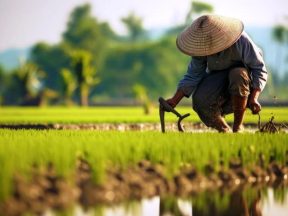Myanmar. One Year later.
On February 1st, 2021, the Myanmar army (Tatmadaw) announced the change of regime in the country.
Within a few hours, the military arrested the leaders of the National League for Democracy (NLD), the party that won the elections twice in five years, gaining about 80% of the seats in Parliament in November 2020. The army’s key target was Aung San Suu Kyi, an icon for Myanmar’s people and a symbol of the battle against the military.
From that date, a tough fight began with thousands of men and women taking the streets all over the country to protest against the military regime. Among them, there were many young people. But after a few weeks of peaceful demonstrations, it became clear that the clash with the military would have been hard and relentless.
The Tatmadaw is now engaged in a de facto civil war with the Government of National Unity (NUG), a shadow government largely composed by NLD’s MEPs, but also by ethnic representatives such as the interim president Duwa Lashi Ladel of Kachin, and civil society members.
The military, who led the country since the 1962 coup d’état, miscalculated the tenacious and lasting determination against their regime. A resistance movement emerged, overcoming historical mistrust between the Bamar majority, dominant in the NLD, and the representatives of ethnic minority groups, that for years had been fighting against the Bamar-dominated central government.
The resolve of the civil society, in agreement with the NUG, made a resistance army possible. The PDF (People’s Defense Force) was born, a real resistance army reinforced thanks to alliances with heavily armed ethnic organizations.
“It is difficult to make a proper estimate of the PDF’s military numbers”, said Aung Kyaw advisor of Alliance For Democratic Myanmar, an NGO supporting the return of democracy in the country. “The resistance army is made up of independent groups that do not recognize a central authority. Roughly, we can estimate 40,000 units. In the Sagaing region, a particularly strategic state in the centre of the country, close to the capital Naypyidaw and therefore to military power, the PDF is rather powerful, counting on at least 20,000 men.”
Aung Kyaw continued: “A large support network is also active in several urban centres, but it is difficult to precisely quantify it. The armies of ethnic groups need to be taken into account, including the KNPP (Karenni National Progressive Party) from Kayah and the CNF (Chin National Front), an armed group of the Chin minority.”
“ KIA (Kachin Independence Army) is the army of Kachin, the northernmost state of former Burma. While not opening declaring it, it is very active in the fight against the military junta. KIA, a historic enemy of the Tatmadaw, is fighting in Sagaing, alongside the PDF.
Some brigades of the KNU (Karen National Union), mainly active in the south-eastern part of the country, joined the battle, too. Summing up, the Burmese resistance can count on between 60,000 and 80,000 units”, he pointed out.
According to Thant Myint U, a historian and one of the leading experts on Myanmar, the Burmese army can count on about 300,000-350,000 soldiers, of which only half of them with real combat capabilities. It seems like an uneven fight, also because the Burmese military is among the best equipped armies in Asia.
In December 2021 Aung San Suu Kyi, was found guilty of inciting dissent and breaking Covid rules in the first of a series of verdicts that could see her jailed for life. Furthermore, five new charges have been recently added, concerning the rental and purchase of a helicopter that allegedly caused a loss of state funds.
According to Assistance Association for Political Prisoners, a Bangkok-based NGO, starting from the February 1st coup d’état, there have been 1495 death sentences and 12.000 people imprisoned for political motivations.
The coup and the pandemic have had a devastating effect on economic growth. According to the World Bank, the economy is around 30 percent smaller than it might have been in the absence of COVID-19 and military coup. Over the past year, millions of people have lost their jobs and livelihoods. The price of essential food products rose, while the national currency, the kyat, plummeted, driving up the cost of imports, including fertilizers and gasoline, with enormous consequences for internal transport costs.
Public services collapsed, too. Doctors and teachers have been at the forefront of the CDM (Civil Disobedience Movement), and many of them continue to refuse to work under the junta. On the other hand, those who keep working face violent retaliation from the local community. The result is the disarray of the health system. Same story for the education system: for the most part, schools are still closed or with few teachers, and even fewer students.
The bulk of the population, including in cities, is sliding into poverty and malnutrition. According to Save the Children, in the last year at least 150,000 children have been forced away from their homes, exposed to hunger, risk and disease.
Recent data from the United Nations show that, since the junta took power, at least 405,700 people have been displaced due to the fighting, a figure that has increased by 27% in the last two months.
In short, while the military escalation continues to intensify, chaos is growing in the country. The State appears to be completely dysfunctional, while the military is no longer able to manage it.
The country is less and less at the centre of the international scene. The Afghan crisis, the situation in Ukraine and the rising tensions between the Western world and some authoritarian regimes moved resources and media attention away from former Burma.
ASEAN, the Southeast Asian association, whose Chairmanship recently passed to Cambodia, a close ally of China, softened its position towards Naypyitaw. After long internal negotiations, Indonesia, Malaysia and Singapore have managed to obtain an agreement to put Myanmar under pressure, excluding the military leader Min Aung Hlaing from ASEAN summits. At the beginning of January, amid much controversy, Cambodian Prime Minister Hun Sen decided to visit Naypyitaw. As expected, no results came out of the visit.
Myanmar is a complicated game for China, too. Even if Beijing cares about the stability of the country, it does not seem to have a clear decisive strategy. In the meanwhile, a whole young generation, the most committed to resistance, continues to fight and die notwithstanding the world’s indifference, being aware that they can only rely on their own strength. (Photo: Protest in Myanmar against Military Coup. CC BY-SA 4.0/ Maung Sun)
Francesca Baronio/ISPI



